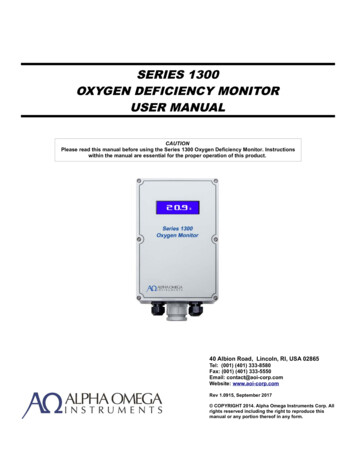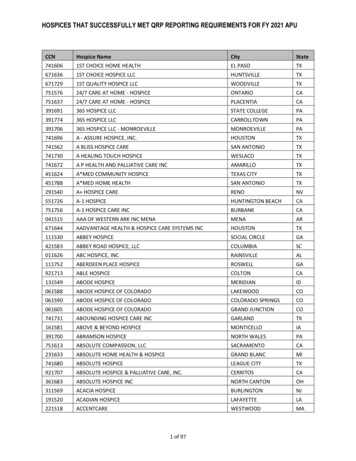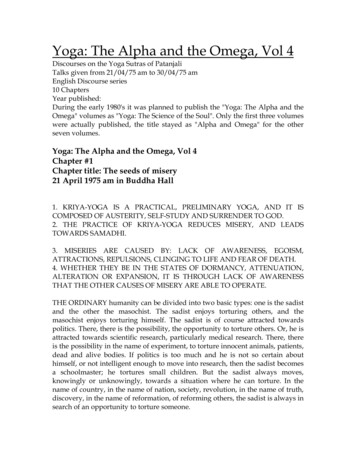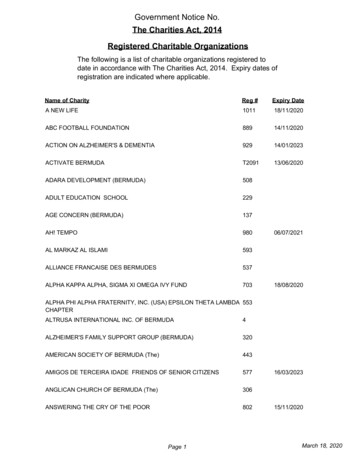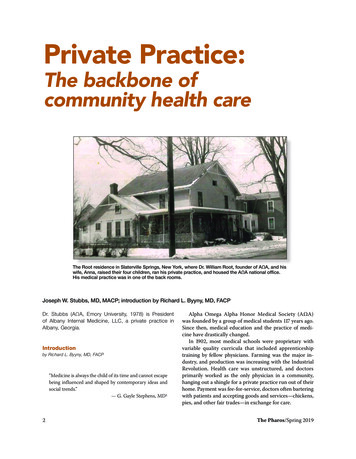
Transcription
Private Practice:The backbone ofcommunity health careThe Root residence in Slaterville Springs, New York, where Dr. William Root, founder of AΩA, and hiswife, Anna, raised their four children, ran his private practice, and housed the AΩA national office.His medical practice was in one of the back rooms.Joseph W. Stubbs, MD, MACP; introduction by Richard L. Byyny, MD, FACPDr. Stubbs (AΩA, Emory University, 1978) is Presidentof Albany Internal Medicine, LLC, a private practice inAlbany, Georgia.Introductionby Richard L. Byyny, MD, FACP“Medicine is always the child of its time and cannot escapebeing influenced and shaped by contemporary ideas andsocial trends.”— G. Gayle Stephens, MD12Alpha Omega Alpha Honor Medical Society (AΩA)was founded by a group of medical students 117 years ago.Since then, medical education and the practice of medicine have drastically changed.In 1902, most medical schools were proprietary withvariable quality curricula that included apprenticeshiptraining by fellow physicians. Farming was the major industry, and production was increasing with the IndustrialRevolution. Health care was unstructured, and doctorsprimarily worked as the only physician in a community,hanging out a shingle for a private practice run out of theirhome. Payment was fee-for-service, doctors often barteringwith patients and accepting goods and services—chickens,pies, and other fair trades—in exchange for care.The Pharos/Spring 2019
William Root, MD, the physician credited with establishing AΩA, was a community physician who for severaldecades cared for the people of Slaterville Springs, NewYork, and surrounding communities.Medical residency training in hospitals began in thelate 19th century to provide more experiential educationand training with increasing responsibilities for physicians.Residencies in medicine became structured and institutionalized for the principal specialties in the early 20thcentury, but even by mid-century only a minority of physicians participated. After World War I, the medical doctordegree was given upon graduation from medical school,but the license to practice was administered by each stateboard. Doctors-in-training became known as interns. Bythe mid-1920s the internship had become required of allUnited States medical graduates to get a medical license.By 1935, there were major changes to medical education,including standardization of the pre-doctoral medical education, that awarded all physicians the same medical degree;specialization was based on extended graduate educationor residency. That led to increased specialization and subspecialization; and the use of technology. Hospitals becamea major focus of medicine using and developing technology,and medicine became more institutionalized, based in medicalschools and city/county hospitals and evolving health systems.The medical residency became the defining educationalfeature providing residents with the responsibility of patient management. Residents evaluated patients, madedecisions about diagnosis and therapy, and performedprocedures and treatments. They were supervised by—andaccountable to—attending physicians, but they were allowed considerable clinical independence. The residencyexperience emphasized scholarship and inquiry as muchas clinical training, and was considered the best way forlearners to be transformed into mature physicians.Between 1940 and 1970, the number of residency positions at United States hospitals increased from 5,796 to46,258. Thus, the number of residents seeking specialtytraining soared.2 However, during this time, private practice and fee for service medicine remained the predominate praxis of medicine.Private practices in the U.S.The American Medical Association has conductedseveral surveys with physicians in private practice. Inthe 1980s, physician practice ownership was dominant.In 1983, 76.1 percent of physicians were practice owners;however, in 2012 that number had dropped to 53.2 percent.The year 2016 marked the first year in which physicianThe Pharos/Spring 2019practice ownership was no longer the majority. Accordingto data from that year’s survey, only 47.1 percent of physicians were practice owners, of which 27.9 percent wereunder the age of 40, and 36.6 percent were females withsome ownership stake.3The report indicated, “most physicians—55.8 percentin 2016—continue to work in practices that are whollyowned by physicians.” 3 The report also showed that 13.8percent of physician work at practices with more than 50physicians; however the majority, 57.8 percent, practicein offices with 10 or fewer physicians. The most commonpractice type is the single specialty group.Multispecialty group practices are more likely to bewholly or partially hospital owned. The number of physicians working in practices owned by a hospital or integrated delivery system is more than 50 percent. 3 Anumber of factors are involved in these changes, includingphysician payment and compensation plans; outstandingstudent debt; the complex business of medicine; practiceexpenses; expanding use of technology, e.g., EMR; lifework integration; pursuit of higher paying specialties byphysicians and corporate hospital and entities; complexregulations; and professional perceptions.Despite these changes private practice remains common,especially in less populated and rural areas of the country.A pillar of the communityJoseph W. Stubbs, MD, MACP has been in private practice specializing in internal medicine and geriatrics for 37years in the relatively small diverse city of Albany, Georgiaon the Flint River. He is a physician owner of AlbanyInternal Medicine.Joe graduated summa cum laude from William andMary in 1975. He received his medical degree, also summacum laude, from Emory University School of Medicinein 1979. He did his residency and was Chief Resident ininternal medicine and primary care at the University ofWashington affiliated hospitals in Seattle. Joe is boardcertified in internal medicine and geriatric medicine and isa Master of the American College of Physicians.As a community physician, Joe has published scholarlyarticles in Lancet and the Annals of Internal Medicine,and is very active as a physician and leader at PhoebePutney Memorial Hospital in Albany. He is President ofthe Albany Internal Medicine Private Medical Group; aClinical Assistant Professor of Medicine at the MedicalCollege of Georgia at Augusta University; and ClinicalAssistant Professor of Community Medicine at MercerUniversity School of Medicine.3
Private Practice: The backbone of community health careDr. Root’s medicalbag.Dr. Root setting out on a house call in his Buick, circa 1923.He is a leader in his local community, the state ofGeorgia, and nationally. He is an active member of theAmerican College of Physicians (ACP) Georgia Chapter,and joined the Georgia ACP Governor’s Council in 1988where he has served on the Public and ProfessionalCommunications Committee, the Health and PublicPolicy Committee, and as Chapter Secretary.Joe was elected to serve as the ACP Governor forGeorgia from 1999 to 200 3. In 2003, he was named aLaureate of the ACP Georgia Chapter and was recognizedby ACP with an Evergreen Award for outstanding chapteractivities and advocacy. He served two terms on the ACPBoard of Regents, where he was Chair of the MedicalService Committee, and the Services Committee, andserved on the Scientific Program Committee, the MemberInsurance Subcommittee, the Publication Committee, andthe Managed Care Subcommittee. He was the Chair of theACP Foundation in 2009/10, and served as President ofthe American College of Physicians that same year.He is a Master of the American College of Physicians,Fellow of the Royal College of Physicians in Edinburgh,and Fellow of the Royal College of Physicians of Ireland.Joe was elected to the Board of Directors of the AlphaOmega Alpha Honor Medical Society in 2008, and served asPresident in 2016. He serves as the Chair of the InvestmentCommittee, and sits on the Leadership Committee.Throughout his career as a community practice physician,Joe has been an accomplished leader, teacher, mentor, and4community member. He is the personification of the privatepractice physician who preserves and cultivates his localmedical community as well as the medical profession at-large.Private Practice: The backbone of communityhealth careby Joseph W. Stubbs, MD, MACPI remember looking around the boardroom at my firstnational AΩA board meeting in 2008, and realized I wasthe only one practicing clinical medicine full-time in aprivate practice. All the others were accomplished facultymembers and leaders of academic medical centers or major medical organizations, or incredible medical students. Iwondered if this was just some opportunity for me to takerefuge from the blistering challenges I face each day in theoffice, or did I really have something to contribute to thisamazing group and organization. I asked myself, “Is AΩAreally relevant to my work in private practice?”Many of my colleagues in private practice perceiveAΩA to be an organization that recognizes medical students for academic and professional excellence, and haslittle relevance to those of us in private practice.At that first meeting, I looked at my briefing book andon the front cover was the insight for which I was searching,“Be worthy to serve the suffering.” I then realized that AΩAis an organization that fosters academic excellence, teaching, and research, but more importantly, it is an institutionthat carries the torch of professionalism. This seeminglyThe Pharos/Spring 2019
simple almost trite motto contains within it profoundand foundational implications for practicing physicians.The call for professionalism needs to be as loud and ascentral in private practice as it is in any other corner of theHouse of Medicine.Our worthiness is not derived from title, status, financial wealth, or family background, but rather from anintense desire to serve. It involves a willingness to be vulnerable for the sake of others; to humbly replace our ownneeds with those of the patient; and to be physically andmentally present for our patients.The ties that bindEarly in my career I was on-call for our medical practicewhen a patient of one of my partners who had been in thehospital multiple times with congestive heart failure wasonce again admitted and was not going to make it. Thefamily and patient pleaded with me to have my partnercome and see him. Though I knew how much my partnerstreasured their few moments away from work, I wentahead and called and informed him of the situation. He didnot hesitate. He thanked me for calling and immediatelycame to the hospital. He met with the family expressinghis condolences, and then used silence to give space forthe family’s grief. He held the spouse’s hand and said, “Youcared for him so lovingly and did all you could do.” Hiswords and presence were a defining moment in that family’s ability to accept death and begin healing.In return for the inconvenience of coming to the hospital when not on call, my partner experienced a sense ofgratification and fulfillment through that deeply humandoctor-patient relationship.It’s not always what it seemsWorthiness to serve requires trust—trust that as a community physician, and often times friend, you will be honestand forthcoming with patients. I once lost the trust of anelderly female patient who suffered from painful shoulderarthritis, despite multiple efforts to treat it. On one officevisit she blurted out as soon as I walked in the room, “Whydidn’t you tell me about Viagra to help my shoulder pain!”I replied in a confused tone, “Viagra?”She said, “Yea, you know that drug being advertisedwhere this guy tries to throw a football through a swinging tire but can’t even get the ball to the tire, and then withViagra he is able to throw that football like a rocket rightthrough the center of the tire.”I hesitantly replied, “So, you think Viagra helped himwith his arthritic shoulder?”The Pharos/Spring 2019“Of course,” she replied, “what else could it help?”She had lost trust in my ability to care for her shoulderpain because I had not prescribed Viagra. Needless to say,the conversation to regain her trust was a delicate one, andnot without some embarrassment as this woman was notonly a patient but someone with whom I interacted with inthe community.Reliability and accountabilityTrust also involves reliability and accountability. Thiscan be simple, everyday things: returning phone calls onthe same day the patient placed the call; or taking the timeto alert other physicians who care for the patient aboutimportant changes in medications or conditions. Or, it canbe big things like accepting responsibility and acknowledging when mistakes are made. It involves being transparentabout prices you charge, and about your clinical outcomes.A patient’s trust comes from a belief that you as theirphysician are committed to stand by them throughouttheir illnesses, offering realistic hope, and doing all you canwhether it be for cure or for comfort. It comes from yourpatients knowing you not only as their doctor, but also astheir fellow community member who they see and interactwith at church, the grocery store, and community events.As a community physician you are many things to manypeople, all of which require confidentiality, reliability, accountability, trust, and friendship.Opportunity trumps scorecardsThe AΩA motto states “to serve,” not to treat or to carefor. As community physicians, we must always be mindful about rendering care in a manner that respects thepatient’s autonomy and ability to choose. I am a physicianwho, like all others, aspires to excel, particularly when itcomes to quality scores. I like the blood pressures under140/90, and the A1Cs less than eight.My patient Rosemary was a chain smoker who refusedto even think of quitting, had high blood pressure forwhich she was always forgetting to refill her medications,and was obese but loved Coca Cola. During every visitwith Rosemary my quality metrics sank lower and lower.The quality strategists might suggest dismissing sucha patient due to persistent noncompliance, but such adecision would reflect not knowing the whole person.Rosemary started a soup kitchen for the homeless, caredfor a husband with dementia, always wanted a hug insteadof a handshake, and always wanted to see pictures of mygrandchildren. Sure, I would try to nudge Rosemary intosome more healthy decisions, but often at the end of a visit,5
Private Practice: The backbone of community health careI wasn’t sure who was the patient and who was the healer.The opportunity to serve always trumps scorecards.Committing time and resources to the patientPatients want to be “served” with information and options to make informed decisions with their caregiver.This requires a commitment to continuous learning ofboth clinical skills and scientific knowledge in order toaccurately diagnose and adequately inform the patient.The exponential growth in medical research and advancesin medical knowledge make this very challenging. In theblink of an eye, something in the standard of care of mypatients will have changed.“To serve” also requires communication and time. Today,for every hour in the room with the patient, physicians arespending two hours doing paperwork, documentation, andelectronic health record (EHR) work. Even during the time inthe exam room with the patient, physicians are spending closeto 40 percent doing paperwork and documenting in the EHR.We need to turn this communication pyramid on itshead because it is paramount that patients feel their storieshave been heard before they are willing to become engagedin our assessments and treatment plans. They need to feeltheir stories are heard not just with ears, but with eyes,hands, and most importantly with the heart.We have powerful and effective medications and treatments at our disposal, but none more effective and potentthan empathy. The words of Francis Peabody are as truetoday as they were when in 1927 he said, “The secret of thecare of the patient is in caring for the patient.” 5In today’s world of highly specialized health care, ourresponsibility as communicators is not just with the patientbut also with the other physicians and health professionals.This has become extremely daunting at times as patientsover 65 years of age are likely to see seven different physicians and fill 20 different prescriptions each year. Further,a primary care physician is likely going to annually interactwith 220 other physicians in 117 different practices.6The lack of coordinated care due to inadequate communication can prove disastrous. For example, a primarycare physician refers a patient with abdominal pain to asurgeon for possible gallstone disease. The surgeon seesthe patient, does a CT of the abdomen showing the gallstones but also sees a mass in the liver that turns out tobe a hepatocellular carcinoma. The surgeon removes thegallstones and sends to patient back to the primary carephysician, but the primary care physician never hearsabout the CT report showing a mass in the liver, resultingin a tragic delay of diagnosis.6We need to break down our silos of practice and expertise and find ways of sharing and communicating withone another. Much has been written about measures toresolve these care coordination problems such as HealthInformation Exchanges and referral contracts. All of thesemay be beneficial, but sometimes the simplest thing to dois just pick up the phone and call one another.We are not there to serve just one sufferer or one patient, but to serve the population of “suffering”, as a whole.As practicing physicians, we must take responsibility andaccountability for the stewardship of the needed healthcare resources for all patients if we are to continue to havethose resources for our own individual patients.In 1970, total health care spending was about 75 billion, or 356 per person. In less than 40 years these costshave grown to 2.6 trillion, or 8,402 per person. As aresult, the share of economic activity devoted to healthcare grew from 7.2 percent of the Gross Domestic Product(GDP) in 1970 to 17.9 percent of the GDP in 2010. TheUnited States’ health care costs far exceed other nations.Our 8,000 per person per year expenditure on health careis 50 percent more than the next highest industrialized nation (Switzerland), and 90 percent higher than many globalcompetitors.7 Yet, our quality of health metrics, such asinfant mortality, mortality amenable to health care, andsafety are in the cellar when compared with other industrialized nations.8 To make matters worse, the Institute ofMedicine estimates that approximately 750 billion annually, or 30 percent of medical expenditures, are spent onunnecessary care, inefficiently delivered care, excessiveadministrative costs, or fraud.9Private practice/community physicians understandthese issues all too well. They bring an expertise on whatis needed, and what is important, on the front lines of patient care. They are leading the way in the implementationof care models that are more patient centric where thepatient is not a care recipient but a care participant. Theyare developing models where reimbursement is valuebased rather than volume-based. New team-based modelsof care, such as the patient-centered medical home, aretransforming the practice of medicine where physiciansare leading a team of medical professionals, all working atthe top of their licenses, to provide continuous, comprehensive, coordinated, quality care.Engaging the private practice physician in AΩAWe need to find ways of fostering more continuedengagement of the private practice of medicine in AΩA.Much can be done at the Chapter level. Although our 132The Pharos/Spring 2019
Chapters reside in medical schools, they need to find waysof reaching beyond the walls of academia. With the helpof the national AΩA office, Chapters need to find waysof identifying active AΩA members in private practice intheir locales. AΩA physicians in the community need tobe invited and encouraged to participate in the programsfor electing and recognizing new AΩA members.Each year, Chapters can elect as members three to fivealumni who were not previously selected to AΩA but whohave excelled in leadership, teaching, service, and professionalism. Chapters need to find ways of engaging AΩAmembers in the community to help in the identificationand selection of such individuals. The broadening of theAΩA community beyond medical schools and academichealth centers has a plethora of dividends. It fosters mentoring opportunities and encourages community physicians to serve as volunteer clinical faculty.Participation in my local AΩA Chapter activities andceremonies has had a powerful impact on me, remindingme, again and again, of why I became a physician, and reinforcing my commitment to “being worthy.”At the national level, the engagement of AΩA members in private practice needs to continue to be a priority. The majority of those “worthy to serve the suffering”are indeed in private practice. And, the AΩA Boardof Directors needs to continue to find ways of seekingout qualified candidates in private practice to serve asBoard members.Engaging the interest of private practice AΩA memberscould occur through some of the national programs, suchas the Fellows in Leadership program, which enhances theleadership skills of early to mid-career physicians in academic centers, medical organizations, or private practice.Since the inception of the program in 2014, there havebeen very few applications from people in private practice,and only one Fellow from private practice.Additionally, to create engagement of the private practice physician, AΩA could consider the creation of a newaward for private practice physicians, such as an AΩAInnovator’s Award for members who in the practice ofmedicine help create novel solutions for health care delivery that create more patient centric, less costly, and betterquality care.Efforts to enhance the engagement of the private practice of medicine in the AΩA will be challenging but a benefit for all. With it, AΩA will be a stronger, more diverseorganization and have a greater impact on the quality ofhealth care in this country. Likewise, AΩA members inprivate practice need AΩA as a compass that always pointsThe Pharos/Spring 2019them North, in the direction of professionalism, as a beacon illuminating a path of joy and fulfillment that being aphysician can offer.Ultimately, it is the suffering who we are worthy toserve who benefit the most from the unique breadth andknowledge that the private practice/community physicianbrings to the profession of medicine. These physicianshave been a staple of the community for centuries, andwith the shared knowledge of their academic health centerpartners, they will continue to be the local doctor with ashingle and black bag caring for families.References1. Stephens G. The Intellectual Basis of Family Practice.Greensburg (IN): Winter Publishing Company; 1982.2. Curtis JL. Affirmative Action in Medicine: ImprovingHealth Care for Everyone. Ann Arbor (MI): University ofMichigan Press; 2009.3. Murphy B. For first time, physician practice owners arenot the majority. AMA Practice Management Economics.May 31, 2017. ajority.4. Sinsky C, Colligan L, et al. Allocation of Physician Timein Ambulatory Practice: A Time and Motion Study in 4 Specialites. Ann Internal Med. 2016: 165:.753-60.5. Peabody FW. The Care of the Patient. JAMA. 1927: 88:877-82.6. Medicare Payment Advisory Commission Report to theCongress: Increasing the Value of Medicare. Chapter 2. Carecoordination in fee-for-service Medicare. Washington, DC.Medicare Payment Advisory Commission 2006.7. Kaiser Family Foundation. Health Care Costs: A Primer.May 1, 2012. s-a-primer-2012-report/.8. Squires D. U.S. Health Care from a Global Perspective:Spending, Use of Services, Prices, and Health in 13 Countries. The Commonwealth Fund; October 8, 2015. e.9. Smith M. Best Care at Lower Costs: The Path to Continuously Learning Health Care in America. Institute ofMedicine of the National Academies; September 6, ly-LearningHealth-Care-in-America.aspx.The author’s E-mail address is josephwstubbs@gmail.com.7
Joe graduated summa cum laude from William and Mary in 1975. He received his medical degree, also summa cum laude, from Emory University School of Medicine in 1979. He did his residency and was Chief Resident in internal medicine and primary care at the University of Washington affiliated hospitals in Seattle. Joe is board-


